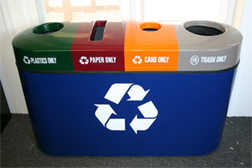 With different rules and recycling services for each city, it can be difficult to have a firm grasp on what exactly is recyclable and what’s not. Even the most environmentally conscious folks stop short when it comes to disposing of certain food containers. It sounds right to be safe rather than sorry by just throwing that item we’re not sure about in the recycling. However, it turns out that this method of thinking is causing more harm than good.
With different rules and recycling services for each city, it can be difficult to have a firm grasp on what exactly is recyclable and what’s not. Even the most environmentally conscious folks stop short when it comes to disposing of certain food containers. It sounds right to be safe rather than sorry by just throwing that item we’re not sure about in the recycling. However, it turns out that this method of thinking is causing more harm than good.
According to The Coloradoan, putting non-recyclable items into the recycling bin is what drives loads of recyclable items to landfills. Why? How is this possible?
Well, for one, many items that we think are recyclable are actually contaminated. Take a greasy pizza box, for instance. These cardboard boxes are recyclable on their own, but if they are covered with grease or some other food substance (which they usually are), they no longer can be recycled.
And if these greasy pizza boxes are thrown into recycling, they unfortunately contaminate the items around them, making them non-recyclable as well. So when recyclers try to create new materials out of these recycled items, the brand new items are contaminated and not usable. Therefore, markets and other vendors will not purchase these items from recyclers, which makes the whole process useless and bad for the environment.
This, unfortunately, is bound to happen. Recycling and environmental education is pretty sparse in a lot of communities. And although this may not be affecting us financially at the moment, it could end up costing everyone money in the long run.
For example, recycling services in Fort Collins, Colorado, have to take the waste they find mixed with the recyclable materials and send them to the county landfill. The landfill charges for the amount of trash sent their way, and prices can also depend on what type of waste it is.
This means that the more recycling services find waste in their materials, the more they will have to pay the landfill. If prices continue to go up, the recycling services may find incentive to begin charging residents for recycling who would otherwise get their recyclables picked up for free.
What can you do about this?
The best way to go about avoiding recycling dilemmas is to try to avoid disposable products altogether. For example, instead of purchasing food with a disposable container, make use of your own washable container. A lot of disposable items can be cut out of your life if you practice habits like this. On the other hand, if you have a recyclable item that’s covered with grease or other food remnants, you can always separate or cut out the part that’s contaminated.
We have a long way to go with recycling education and knowing right from wrong when it comes to our recycling bins. But if we take steps to learn the rules of our neighborhood recycling services and choose reusable items over disposable, we can be on our way to making a difference.
Original by April Stearns www.1800recycling.com






































